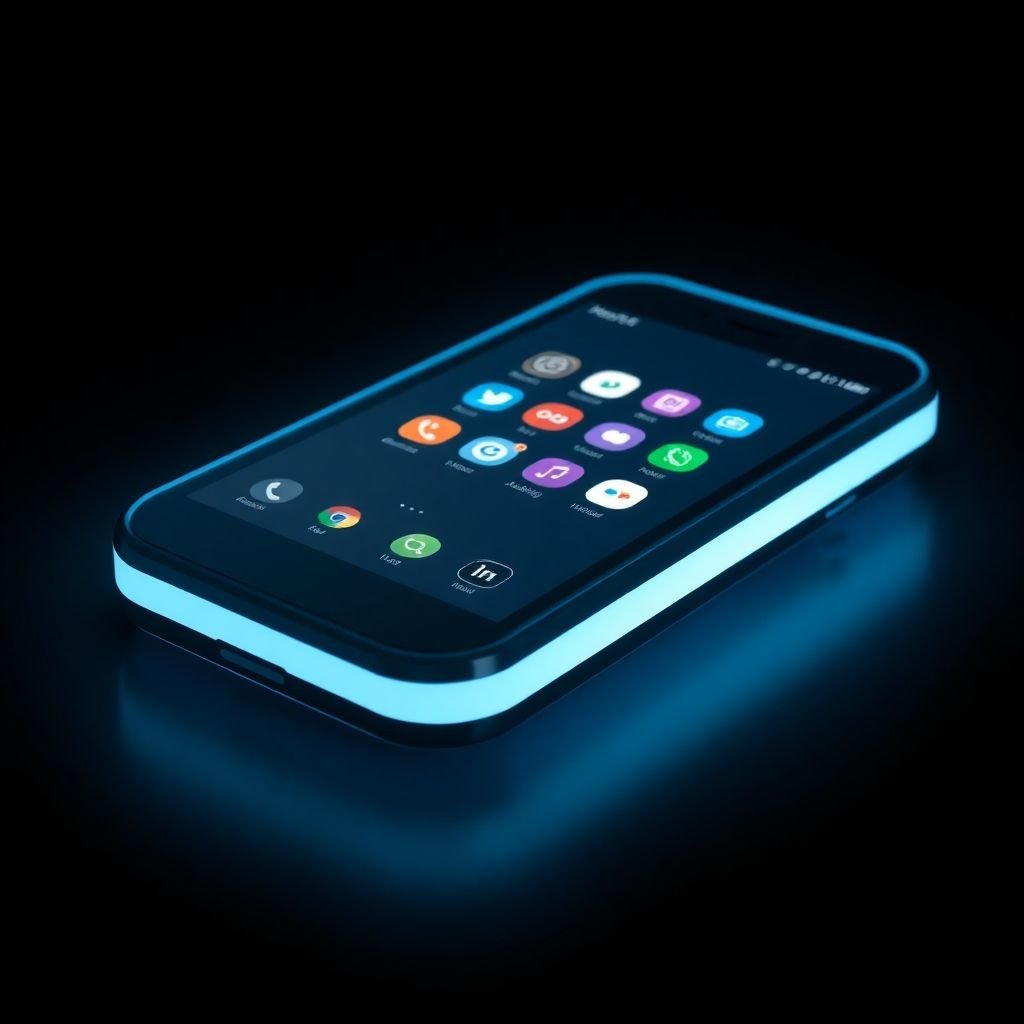In the ever-changing world of technology, the rise of AI has sparked a new wave of innovation in mobile devices. By 2025, we might just be saying goodbye to our trusty smartphones and welcoming a new player into the game: the ChatGPT device. This isn’t just another gadget; it’s set to redefine how we communicate and interact with technology. Let’s explore what this could mean for our daily lives and the future of personal devices.
Key Takeaways
- The ChatGPT device aims to replace traditional smartphones by 2025.
- AI integration will allow for seamless communication and interaction.
- Project Astra will bring advanced features to enhance user experience.
- Visual intelligence will transform how we use devices in everyday situations.
- Privacy and education will be key challenges as AI devices become mainstream.
The Evolution Of Mobile Devices
Understanding The Shift From Smartphones
Okay, so remember when smartphones were the thing? Now, it feels like we’re on the cusp of something else entirely. The shift away from smartphones is driven by a desire for more intuitive and less screen-dependent interactions. People are getting tired of staring at rectangles all day. We’re talking about a move towards devices that understand us better, anticipate our needs, and blend more seamlessly into our lives. It’s not just about upgrading the tech; it’s about changing how we interact with technology altogether.
The Role Of AI In Future Devices
AI is set to be the main ingredient in the next generation of mobile devices. Think about it: AI can learn your habits, predict your needs, and automate tasks. This means future devices won’t just be tools; they’ll be proactive assistants. We’re talking about devices that can manage your schedule, control your smart home, and even offer advice, all without you having to lift a finger. The potential is huge, but it also raises some interesting questions about privacy and control. It’s a bit like having a super-efficient, slightly nosy, digital butler.
Predictions For Mobile Technology
Predicting the future is always a bit of a gamble, but here are a few educated guesses about where mobile tech is headed:
- Less Screen Time: Devices will rely more on voice, gestures, and augmented reality to provide information and complete tasks.
- AI-Powered Personalisation: Devices will adapt to individual user needs and preferences, becoming more intuitive and helpful over time.
- Seamless Integration: Devices will work together more seamlessly, creating a connected ecosystem that simplifies daily life.
The future of mobile technology isn’t just about faster processors and better screens; it’s about creating devices that are more intelligent, more intuitive, and more integrated into our lives. It’s about moving beyond the limitations of the smartphone and embracing a new era of mobile computing.
It’s a pretty exciting time, even if it does mean saying goodbye to our beloved smartphones (eventually).
Introducing Project Astra

Features Of The New Device
Project Astra is shaping up to be a game-changer. It’s designed as a multimodal AI helper, capable of understanding and interacting with its surroundings in a way that feels almost human. Think of it as having a super-smart assistant that can see, hear, and respond to your queries using text, images, or spoken words. It’s currently being tested, but the early demos are impressive. Imagine asking it a question about something you’re looking at through your phone’s camera, and it instantly provides relevant information. That’s the kind of seamless interaction Project Astra is aiming for.
Integration With Existing Technology
One of the key aspects of Project Astra is its planned integration with existing tech. It’s not meant to be a standalone thing; instead, it’s designed to work with your current devices and services. Google has already shown it off on phones, glasses, and headsets. Android XR, a new operating system with Gemini at its core, is also in the works. This means Project Astra could potentially debut on Pixel devices and maybe even on new headsets. The idea is to make AI a seamless part of your digital life, no matter what device you’re using.
Expected Launch Timeline
While there’s no firm launch date yet, all signs point to a 2025 release for Project Astra. Google is actively testing it, and with other companies like Apple and Samsung also pushing forward with their own AI integrations, the race is on. It’s likely that Project Astra will first appear on Pixel hardware, given Google’s track record. Keep an eye out for more announcements in the coming months. The end of this year has brought a few glimpses of what’s to come in 2025. Project Astra is being tested by people outside of Google, Android XR is the first operating system built with Gemini at the core, and Apple Intelligence is now available with ChatGPT integration.
The arrival of Project Astra is not just about a new device; it’s about a fundamental shift in how we interact with technology. It promises a future where AI is not just a tool, but a true partner in our daily lives.
AI’s Impact On Communication
How AI Enhances User Interaction
AI is changing how we interact with our devices and each other. It’s not just about faster typing or better autocorrect anymore. AI is now capable of understanding context, predicting our needs, and even adapting to our communication styles. Think about it: your device could soon learn to summarise long email threads for you, suggest replies based on the conversation, or even manage your calendar based on requests received via email or messages. It’s all about making communication more efficient and intuitive. The rise of AI adoption is making these features more commonplace.
Voice Commands As The New Norm
Remember when voice commands felt clunky and unreliable? Those days are fading fast. With advancements in natural language processing, voice commands are becoming increasingly accurate and responsive. Soon, we might find ourselves talking to our devices more than we type. Imagine dictating entire emails, controlling smart home devices, or even conducting complex research, all with just your voice. It’s a shift towards a more hands-free, intuitive way of interacting with technology. This will also improve AI capabilities.
Multimodal Processing Explained
Multimodal processing is where things get really interesting. It’s the ability of AI to understand and process information from multiple sources – voice, text, images, and even video. This means your device can understand not just what you say, but also how you say it, and even what’s happening in the background. For example, imagine pointing your device at a foreign menu and having it instantly translate the text and even suggest dishes based on your dietary preferences. Or, consider how AI will monitor data from all sensors, alerting users to potential risks and suggesting dietary and exercise plans for a more active lifestyle. It’s about creating a richer, more contextual understanding of the world around us.
Multimodal processing is not just about combining different types of data; it’s about creating a synergistic effect where the whole is greater than the sum of its parts. It allows AI to understand nuances and subtleties that would be impossible to grasp with a single input method. This will lead to more natural and intuitive interactions with our devices.
Here’s a simple breakdown of how multimodal processing might work in a future device:
- Input: Voice command + image of a product
- Processing: AI analyses both the voice command and the image.
- Output: Device provides information about the product, including price comparisons and user reviews.
The Future Of Personal Assistants

Transitioning From Text To Action
For ages, personal assistants have mostly given us information back in text form. Think about it: you ask a question, and you get a wall of text in return. But that’s changing. AI is starting to do things for us, not just tell us about them. Instead of just giving you directions, your AI could book a taxi. Instead of telling you the weather, it could adjust your thermostat. It’s about moving from being informed to being assisted.
The Rise Of Ambient Computing
Ambient computing is about making technology fade into the background. Instead of interacting directly with devices, the environment itself responds to your needs. Imagine walking into your house, and the lights automatically adjust to your preferred setting, the music starts playing softly, and the temperature is just right – all without you touching a single button. It’s like having a digital butler that anticipates your every need. This shift requires AI to be seamlessly integrated into our surroundings, understanding context and responding intuitively. It’s less about the device and more about the experience.
AI’s Role In Daily Tasks
AI is poised to take on a much bigger role in our daily routines. Think about how much time you spend on repetitive tasks – scheduling appointments, managing emails, making shopping lists. AI can automate these tasks, freeing up your time and mental energy for more important things.
- Automated scheduling and reminders.
- Smart home management (lights, temperature, security).
- Personalised news and information filtering.
AI might be the key to preventing us from keeping our noses buried in our phones. It will be much more common instead of, ‘let me Google that,’ that this voice [assistant] will enter a conversation you and I are having.
AI could even learn your preferences and habits so well that it can proactively suggest solutions and make decisions on your behalf. It’s about having a truly intelligent assistant that understands your needs and helps you live a more efficient and fulfilling life.
Smartphones Vs. AI Devices

Comparing Functionality And Usability
Smartphones, as we know them, are reaching a plateau. Sure, the cameras get a bit better, and the screens are slightly brighter, but the core experience hasn’t changed much in years. AI devices, on the other hand, promise a fundamental shift. They’re not just about running apps; they’re about anticipating needs and proactively offering solutions. Think of it this way: a smartphone is a tool, an AI device is more like a partner. The usability difference will be stark – less tapping, more talking, and a whole lot more getting things done without even asking.
The Decline Of Traditional Smartphones
It’s not that smartphones will vanish overnight, but their dominance is certainly threatened. The rise of AI smartphones is going to change things. People are getting tired of juggling dozens of apps and endless notifications. They want something simpler, something that understands them. As AI devices become more capable, more intuitive, and more integrated into our lives, the appeal of the traditional smartphone will inevitably fade. It’s a slow burn, but the writing’s on the wall. We’ll see a shift towards devices that prioritise AI-driven experiences over raw processing power and endless features.
Consumer Preferences In 2025
By 2025, I reckon consumer preferences will have shifted significantly. People will be prioritising intelligence over specs. It’s not just about having the fastest processor or the most megapixels; it’s about having a device that can understand your needs and adapt to your life.
Here’s what I think will be important:
- Contextual Awareness: Devices that know where you are, what you’re doing, and what you need, without you having to tell them.
- Proactive Assistance: Devices that anticipate your needs and offer help before you even ask.
- Seamless Integration: Devices that work together seamlessly, sharing information and coordinating tasks.
The key is convenience. People want technology that simplifies their lives, not complicates them. If AI devices can deliver on that promise, they’ll be the must-have gadget of 2025. It’s all about making life easier, more efficient, and more enjoyable.
The Integration Of Visual Intelligence

How Visual Recognition Will Change Usage
Visual recognition is set to transform how we interact with our devices. Imagine pointing your phone at an object and instantly receiving information about it – no more endless searching! This technology will make our devices far more intuitive and helpful. It’s not just about identifying objects; it’s about understanding context and providing relevant information in real-time. This shift will change how we use our phones, making them less about manual input and more about instant understanding. Samsung will follow suit with their own visual recognition tech.
Applications In Everyday Life
Visual intelligence will have a huge impact on daily life. Think about these scenarios:
- Shopping: Point your phone at a product to see reviews and compare prices.
- Travel: Translate signs in real-time or learn about landmarks just by looking at them.
- Education: Identify plants and animals on a nature walk, or get instant explanations of complex diagrams.
The possibilities are endless. Visual recognition will make our devices more useful and integrated into our daily routines. It’s about making information accessible and convenient, no matter where you are or what you’re doing.
The Future Of Augmented Reality
Augmented reality (AR) is about to get a whole lot more interesting. With visual intelligence, AR apps can understand the world around you in real-time. This opens up new possibilities for gaming, education, and even everyday tasks. Imagine using AR to visualise furniture in your home before you buy it, or getting step-by-step instructions overlaid on the real world as you repair something. The combination of visual recognition and AR will create truly immersive and useful experiences. iPhone 16 is leading the charge in this area.
Challenges And Considerations
Privacy Concerns With AI Devices
Okay, so these AI devices are cool and all, but let’s be real – privacy is a massive worry. Think about it: these things are listening and watching all the time. It’s not just about targeted ads anymore; it’s about who has access to all that data and what they’re doing with it. Are companies selling our information? Is the government snooping? It’s a minefield, and we need some serious rules in place.
The Need For User Education
Loads of people are still struggling to understand how their smartphones work, so how are they going to cope with an AI device that’s supposed to replace it? There’s a real need for user education here. It’s not enough to just release a fancy gadget; people need to know how to use it safely and effectively. Otherwise, we’re just creating a generation of confused and frustrated users. I think there should be workshops, online tutorials, and maybe even in-store demos to help people get to grips with the tech.
Potential Market Barriers
Getting these AI devices into everyone’s hands isn’t going to be easy. There are a few hurdles to jump over. First, there’s the cost. If these things are too expensive, only a small percentage of people will be able to afford them. Then there’s the issue of infrastructure. Do we have the network coverage and data speeds to support these devices everywhere? And finally, there’s the competition. The smartphone market is already crowded, so how do you convince people to switch to something completely new?
It’s important to remember that technology is only as good as the infrastructure and support systems around it. Without proper investment in these areas, even the most innovative devices will struggle to gain traction.
The Future Awaits
As we look ahead to 2025, it’s clear that the ChatGPT device is set to change how we interact with technology. The idea of a phone that understands us better and can perform tasks without us lifting a finger is exciting. Sure, we’ve had smartphones for years, but this feels different. With AI becoming more integrated into our daily lives, we might find ourselves relying less on screens and more on voice commands and smart assistants. It’s a bit like having a personal helper at our beck and call. So, whether you’re ready or not, the future is coming, and it might just be time to rethink what a phone really is.
Frequently Asked Questions
What is Project Astra?
Project Astra is a new device that aims to replace your smartphone by integrating advanced AI features, making communication and daily tasks easier.
How will AI change the way we use devices?
AI will allow us to interact with devices using voice commands and smart actions, reducing the need for manual input.
What features can we expect from the new device?
The new device will have features like voice recognition, visual intelligence, and the ability to perform tasks automatically.
When will Project Astra be launched?
Project Astra is expected to be launched in 2025, likely on Pixel hardware.
How will AI improve communication?
AI will enhance communication by providing more natural interactions and the ability to understand context better.
What challenges might Project Astra face?
Challenges include privacy concerns, the need for user education, and potential barriers in the market.









